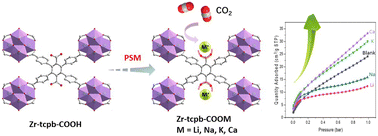A series of cation-modified robust zirconium-based metal–organic frameworks for carbon dioxide capture†
Abstract
Metal–organic frameworks (MOFs) represent one of the most promising porous solids for possible use as sorbents to control and reduce the greenhouse gas emission. Studies have shown that open metal sites (OMS) interact strongly with carbon dioxide and thus, serve as efficient binding sites for CO2 capture. However, many OMS-bearing MOFs are lack of framework stability and often have high regeneration temperature. To seek ways to solve the stability issue, we designed a series of isoreticular MOFs, Zr-tcpb-COOM (M = alkali/alkaline earth metal), by exchange of protons with metal ions on Zr-tcpb-COOH via post-synthetic modification (PSM). The pristine MOF (Zr-tcpb-COOH) has a very robust framework. The PSM process does not deteriorate the framework stability but creates metal binding sites that form strong bonds with carbon dioxide. The results show that at low CO2 pressure, the uptake amount is enhanced considerably using Zr-tcpb-COOM and is in trend of increasing atomic number (Li+ < Na+ < K+ < Ca2+). High adsorption selectivity (CO2/N2 IAST selectivity (15 : 85) = 539.5) is also achieved for CO2 over N2 at room temperature. This approach offers a feasible method to improve CO2 capture capacity, especially at low concentrations.

- This article is part of the themed collection: Introducing the CrystEngComm Advisory Board and their research


 Please wait while we load your content...
Please wait while we load your content...
